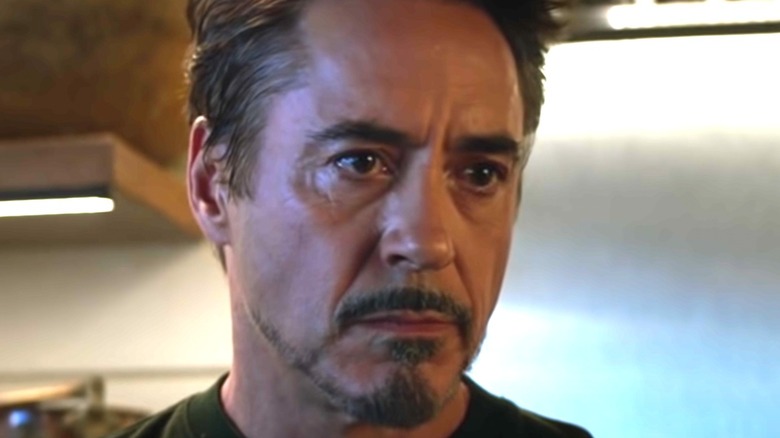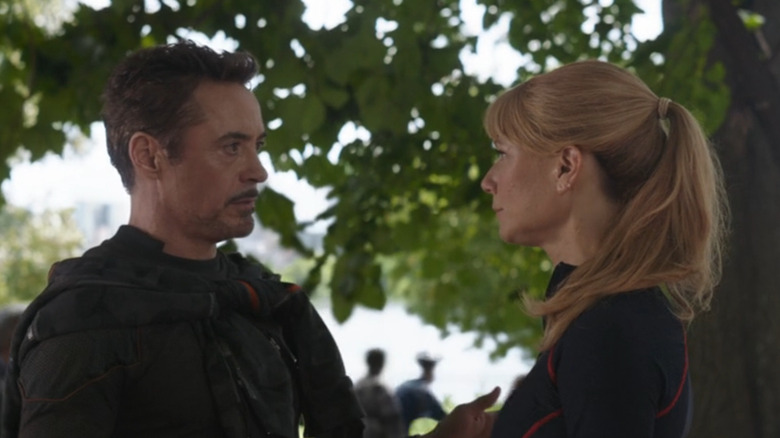What Doctor Strange 2's Multiverse Rules Could Mean For Tony Stark's Dream
Contains spoilers for "Doctor Strange in the Multiverse of Madness"
"Doctor Strange in the Multiverse of Madness" finally gives fans of the Marvel Cinematic Universe their fullest look yet at the wonders of the multiverse. Following up on the events of "WandaVision," the movie shakes up the status quo for both its main characters and the wider MCU as Doctor Strange (Benedict Cumberbatch) and Wanda Maximoff (Elizabeth Olsen) battle their way across the multiverse. Along the way, they encounter alternate versions of themselves, as well as never-before-seen characters from other realities.
In the tumultuous journey through different universes, "Doctor Strange in the Multiverse of Madness" sets up some basic world-building rules governing how these different realities interact with each other. The power of physically traversing between worlds is rare, and only America Chavez (Xochitl Gomez) seems to innately possess it. However, waypoints between realities do exist, such as the one created by the version of Doctor Strange from Earth-838 leading to the Book of Vishanti. Another, less effective method of visiting other universes is the Dreamwalking spell contained in the Darkhold, which allows a person from one reality to possess the body of their counterpart in another. It's also the riskiest method since it can lead to an Incursion, a cataclysmic event destroying one or both realities.
However, it is still possible to see into other worlds through dreams. "Doctor Strange in the Multiverse of Madness" explains that dreams are a window to the life of a dreamer's counterpart in another version of reality. Whatever someone sees in their dreams is actually happening to a variant of themselves from elsewhere in the multiverse. This concept recontextualizes several moments from previous MCU films, most especially one Tony Stark (Robert Downey Jr.) scene from "Avengers: Infinity War."
Tony's dream of parenthood could have a more poignant meaning
As part of its world-building, "Doctor Strange in the Multiverse of Madness" reveals that, within the MCU, dreams are visions into one's other multiversal realities. For instance, Wanda knows her children exist in other universes because she dreams about raising them. America Chavez, on the other hand, doesn't dream at all because no other versions of her exist. This piece of information casts previous events from MCU history in a different light. Any dreams characters have had throughout the franchise can now be interpreted as real events that took place in another version of reality.
One scene that may now have greater implications is a moment from early in "Avengers: Infinity War," where Tony Stark tells Pepper Potts (Gwyneth Paltrow) that he had a dream in which they were married and had a daughter. Notably, that dream does come true for Tony later on, as he has a child named Morgan (Lexi Rabe/Katherine Langford) with Pepper after the Avengers are defeated by Thanos (Josh Brolin). However, since we now know dreams are a peek into other versions of oneself in the multiverse, it's possible Tony's dream was a glimpse into a universe where he and Pepper had their kid earlier in life.
Across the multiverse, there may be versions of Tony whose relationship with Pepper evolved differently. Some universes may have versions of them who worked through their issues earlier, resulting in them having a child earlier; others may have versions where Tony and Pepper don't have kids. In the comics, they never have children together, and in "Tales of Suspense Vol. 1 #91," Pepper ends up marrying Happy Hogan instead. Given the MCU's attention to detail, it's likely all of these endless possibilities were considered when "Doctor Strange in the Multiverse of Madness" was written.

